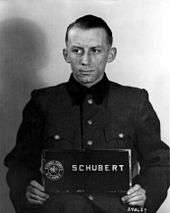Heinz Schubert (SS officer)

Heinz Hermann Schubert (27 August 1914, Berlin – 17 August 1987, Ahrensburg) was a German SS officer. He was sentenced to death at the Einsatzgruppen Trial in 1948, which was later commuted to 10 years imprisonment.
Origin
Heinz Hermann Schubert was born in Berlin shortly after the outbreak of the First World War. He went to school in Eisenberg, Thuringia and then again in Berlin-Lichterfelde, where he attended also a commercial college. From April 1931 to August 1933 Schubert worked for a lawyer.[1]
Nazi career
From August 1933 Schubert worked as a civilian employee for the Reichsstatthalter of Bremen and Oldenburg, headquartered in Bremen. On May 1, 1934 Schubert joined at the age of 19 years the Nazi party, on October 10, 1934 Schubert joined the SS. With the same date he started to work for the Sicherheitsdienst (SD).[1] Prior to his use in the Einsatzgruppe D Schubert worked in the department I A 4 (personal details of the SD) of the Reich Main Security Office (RSHA).[2]
Use during World War II (1941–1945)
In October 1941 Schubert came as an adjutant of Otto Ohlendorf to the staff of the Einsatzgruppe D.[3] In December 1941 Schubert became the order to organize and oversee the killing of about 700 to 800 people in Simferopol. Schubert set the location of the shooting, secluded enough to avoid witnesses. The victims were loaded in the gypsy quarter of Simferopol on delivery trucks. In July 1942 Ohlendorf left Einsatzgruppe D, which was now led by Walther Bierkamp. He returned to the RSHA in Berlin to conduct there again Amt III (SD Germany and German spheres of life). Schubert remained in the RSHA to the end of 1944 as the adjutant of Ohlendorf. He then worked until the war ended for Hans Ehlich in the Office Group III B.[1]
After the war (from 1945)
1947/48 Schubert was the youngest of 24 defendants in the Einsatzgruppen Trial in Nuremberg; his lawyer was Josef Kössel. The judge was American jurist Michael Musmanno.[4] On April 9, 1948, Schubert was found guilty in all three charges – (1) crimes against humanity, (2) war crimes and (3) participation in a criminal organization – and sentenced to death on 10 April 1948. Despite his young age and rather low service level Schubert belonged together with Willi Seibert and Hans Gabel (company commander of 4./Reserve-Police-Battalion 9) to the small management team of Einsatzgruppe D under the leadership of Ohlendorf, that murdered approximately 90,000 people.[5] Until the confirment of his death sentence he was brouht to and had to stay in Landsberg prison for war criminals.
Prison time and release
After the outbreak of the Korean War the discuusion about the Wiederbewaffnung was intensified from summer 1950 on. This was the reason for high commissioner John J. McCloy on 31 January 1951, due to the recommendations of the "Advisory Board on Clemency for War Criminals" to change 15 death sentences against Landsberg prisoners. This meant, four prisoners to life imprisonment, six prisoners to prison sentences of between ten and twenty-five years. Five death sentences should be carried out.[6] The death sentence against Schubert was converted into a prison sentence of ten years. In 1952 Schubert was released after he was issued his remaining prison time.[7]
Literature
- Andrej Angrick: Die Einsatzgruppe D. In: Peter Klein (Herausgeber): Die Einsatztruppen in der besetzten Sowjetunion 1941/42. Edition Hentrich, Berlin 1997, ISBN 3-89468-200-0. (Volume 6 of the publications of the Gedenk- und Bildungsstätte Haus der Wannsee-Konferenz)
- Hilary Earl: The Nuremberg SS-Einsatzgruppen Trial, 1945–1958: Atrocity, Law, and History. Cambridge University Press, Cambridge 2009, ISBN 978-0-521-45608-1.
- Norbert Frei: Vergangenheitspolitik: die Anfänge der Bundesrepublik und die NS-Vergangenheit. Beck, München 1996, ISBN 3-406-41310-2.
- Trials of War Criminals Before the Nuernberg Military Tribunals Under Control Council Law No. 10. Vol. 4: United States of America vs. Otto Ohlendorf, et. al. (Case 9: "Einsatzgruppen Case"). US Government Printing Office, District of Columbia 1950. In: National Archives Microfilm Publications. NM Series 1874–1946, Microfilm Publication M936. National Archives and Record Service, Washington 1973. (Aussage Schuberts unter Eid: S. 97–98, Auszüge aus dem 98, Auszüge aus dem T04-T0581.htm 581]–584.)
References
- 1 2 3 Records of the United States Nuremberg War Crimes Trials. Vol. 4, United States Government Printing Office, District of Columbia 1950, pp. 97–98.
- ↑ Ronald Headland: Messages of murder: a study of the reports of the Einsatzgruppen of the Security Police and the Security Service, 1941–1943. Fairleigh Dickinson University Press, Madison New Jersey 1992, ISBN 0838634184, p. 237, footnote 80.
- ↑ Andrej Angrick: "Die Einsatzgruppe D." In: Peter Klein (Hrsg.): Die Einsatztruppen in der besetzten Sowjetunion 1941/42. Edition Hentrich, Berlin 1997, p. 105.
- ↑ Records of the United States Nuremberg War Crimes Trials. Vol. 4, US Government Printing Office, District of Columbia 1950, p. 11.
- ↑ Records of the United States Nuremberg War Crimes Trials. Vol. 4, US Government Printing Office, District of Columbia 1950, pp. 581–584.
- ↑ Norbert Frei: Vergangenheitspolitik. Beck, München 1996, pp. 195–233.
- ↑ Eberhard Jäckel (Hrsg.): Enzyklopädie des Holocaust. Vol. 3. S–Z, Argon, Berlin 1993, ISBN 3-87024-303-1, p. 1747.